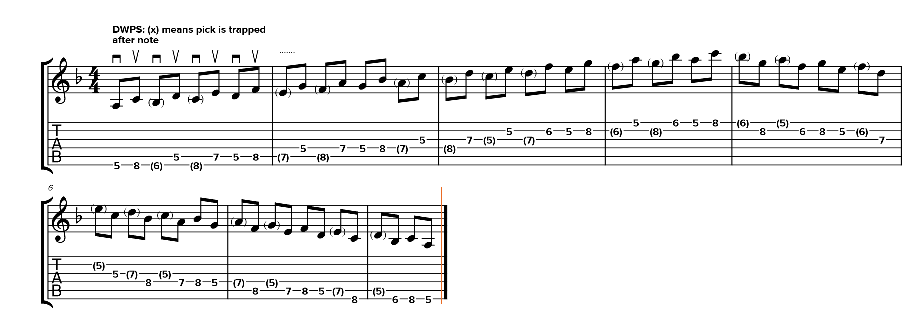I’m playing with notation techniques for trapped pickstrokes. No wonder this little exercise is so evil.
Hey @jllewi, is this a diatonic scale played in “thirds”? (as in 1-3-2-4-3-5-etc.?)
If you are assuming to use only upstroke escape (USX), then of course there will be trapped strokes. However, this type of lick requires double escaped pickstrokes (DBX) in many of the string transitions that you notated.
If you force a USX-only approach it is still possible to play this by swiping (slicing through a muted string) or by the inclusion of hybrid picked notes.
Yes, that’s right. I learned a set of warm-ups long ago from a Mark Whitfield lesson tape when I was starting my jazz exploration. Others include 1-2-3-2-3-4-3-4-5 etc. and 1-2-3-4-2-3-4-5-3-4-5-6 etc. and the descending versions. Up until encountering CtC, I had never considered what made a certain sequence harder to pick than another. Now it’s rather obvious. All of these have lots of string changes.
Michael Schenker does a great descending dom7 7-6-5-4-6-5-4-3… type lick on UFO’s live album Strangers in the Night that I’ve tried to play over the years.
I play this pattern with swybrid picking. In symmetric position, the solution then has the form
|-------------|-------------|
|-------------|-------------|
|-------------|-------------|
|-------------|---------6---|
|---------6---|-7-6-9-7---9-|
|-7-6-9-7---9-|-------------|
d u d u m d d u d u m d
The descending version is
|-7-9-6-7---6-|-------------|
|---------9---|-7-9-6-7---6-|
|-------------|---------9---|
|-------------|-------------|
|-------------|-------------|
|-------------|-------------|
d u d u u m d u d u u m
Incidentally, the fretting pattern for both ascending and descending versions are EDCs.

